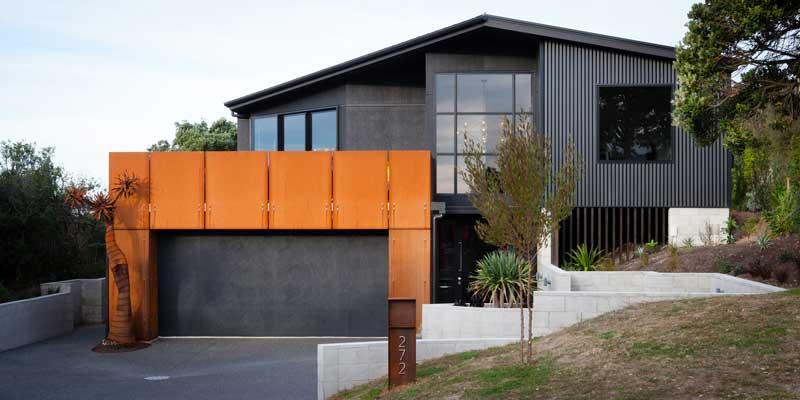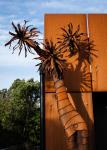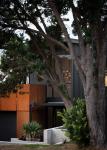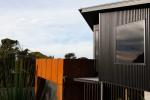Texture, colour, convenience and flair:

This house has it all.
Amy and Lance Vincent love coming home. It’s like finding a box on the doorstep, gift-wrapped in textured black and tied with the sunniest orange ribbon you ever did see.
That’s in some measure a gift from the architect. Architect John Chaplin of Chaplin Crooks Architects is Amy’s Dad. When they bought the Mt Pleasant section the Vincents knew they wanted a home designed around their young family’s lifestyle. They also knew who to turn to.
They drew on John’s experience over the past 35 years of designing on the Christchurch Port Hills. His design maximises both the best views and the shelter and sun for the two outdoor living areas strategically placed at each end of the house.
The Vincents didn’t want a big house – just a functional family home, with flair. John obliged with a stunning architectural statement, flawlessly implemented by Chris Shearer Builders whose firm has been building for as long as John’s been an architect.
The compact 250m2, 2-level house shouts ‘street appeal’. A palisade of eye-catching orange Corten weathering steel panels fringes the road-facing garage. This startlingly sunny orange is set against the almost-black façade of the house itself. The exterior Metalcraft Corrugate cladding is a blend of vertical Colorsteel® in Flax Pod, one of New Zealand Steel’s seven new Architectural Series contemporary colours, and Shadowclad plywood panels in the deeply black Nero of Resene. The COLORSTEEL® Endura roof and all flashings, spouting and downpipes are also in Flax Pod.
On the house’s eastern face Nero is replaced with Resene Starstruck-painted ShadowClad, similar to the bold gold of a kowhai tree – perhaps to harmonise with the resident kowhai tree, perhaps to echo the colourful Corten, and certainly to welcome the morning sun. The house’s relatively flat mono-pitched roof line blends with the Canon Hill terrain and surrounding trees.
The colours and textures of these exterior building materials demand to be acknowledged, especially so when the concrete stack bonded block wall forming the entry and car parking retaining wall is factored in, along with the smoky-toned exposed aggregate finish on the driveway and pathways.
The block wall extends the full length of the house, forming the main spine and supporting the upper timber framed floor while also enclosing the garage. This stands forward of the front of the house and forms the west-facing upper terrace, onto which opens the main living area on the upper level.
Set on a concrete slab, the lower level extends about 1500cm into the excavated hillside and back partly under the upper level to include, along with the garage, entrance way, two double bedrooms and a bathroom.
The upper level has a long north-facing open-plan living, dining and family area which, to the east, opens out onto a slightly raised timber deck with steps down to a lawn. Here, shaded by their kowhai tree and other natives, the family can enjoy the shelter and natural tranquillity of their back yard while, to the west, the lounge opens invitingly to the terrace and the colourful warmth of its Corten balustrade.
Big windows throughout the house invite light and sunshine which dances off the walls during the day, to be replaced with strategically focused downlights at night.
The centrally located kitchen is recessed, giving access to all living areas. A skylight shafts extra light to the kitchen while the stunning black splashback hosts a myriad of kinetic reflections. This is in contrast to the white painted Gib board interior walls and ceilings and white kitchen joinery, doors and fittings.
Flooring throughout the open-plan living areas and in the commanding entrance way is in European oak boards in a wood-warm off-white toning which offsets the crispness of the white interior. Bedrooms and the family area are carpeted in similar but warmer tonings. Floor and walls of all bathrooms are tiled in translucent marble, complementing the prevalent monotone white. Spectacular colours come with the furniture and artwork.
A glass front door opens to a generous double-storey entry over which hovers a chandelier. A stairway floats up to a corridor which connects the master bedroom and ensuite, laundry, bathroom and study. Double-doors from it open to the living spaces on the northside.
Though difficult, the east-west orientated section itself was a rewarding find for the family. Sited on the ridge of Canon Hill, it slopes gently uphill from the neighbouring Mt Pleasant School. The original house was damaged and then demolished following the February 2011 earthquakes and eventually the 580m2 section was put on the market, its mature trees left pretty well undisturbed.
In the wake of the earthquakes, John’s focus has been on designing for the reconstruction of his city. That’s involved many challenges including helping clients with their rebuilds in the face of bureaucracy. John believes there are many lost opportunities around the post-earthquake city where hillside sites have been abandoned or shunned. He maintains that, with careful design based on essential geotechnical expertise, smart architectural alternatives can overcome established mindsets.




